There are many different types of marketing agencies. The Influencer Marketing Hub has highlighted various influencer marketing agencies since its inception, but we have since expanded to include sections for public relations agencies, influencer talent management agencies, digital marketing agencies, web development agencies, social media marketing agencies, UX/UI agencies, crypto and NFT agencies, eCommerce agencies, and branding agencies. And that doesn’t include agencies that we don’t yet have dedicated sections for, like copywriting agencies, advertising agencies, SEO agencies, content marketing agencies, video production agencies, experiential marketing agencies, and more.
Some agencies are very small – solopreneurs in extreme cases. Alternatively, you will find some agencies that operate globally and have thousands of employees. The largest agency is currently Accenture Interactive, whose estimated revenue is $4.4 billion per annum, operates from 40 offices around the globe and has over 18,000 employees. Accenture is an experiential marketing agency, with numerous big-name clients.
With such a variety of businesses calling themselves an agency, there is no one-size-fits-all way you should structure your marketing agency. It all depends on what best suits your organization.
In this post, we are examining possible options for marketing agency structure, whether you’re still in the planning stages of creating a new agency, or whether you’re reviewing your existing structure and contemplating changing your structure to something more suited to your current needs.
What is a Marketing Agency Structure?
All business organizations follow some form of structure. If you’re a freelancer or solopreneur, the structure is very simple – you do all the necessary tasks of the organization and contract out any that are beyond your capabilities. However, for any marketing agency with a team of two or more, things become more complex.
Note that we are talking about organizational structure here, not ownership structure. We are interested in the internal roles and responsibilities of an agency, not whether you’ve funded it as a sole trader (although that will most likely also lead to a one-person organizational structure), a partnership, or a limited company. Instead, we are looking at how you structure the roles and responsibilities of your management and team.
There isn’t a single “best” organizational structure for your marketing agency to follow. It all depends on the needs of your agency and how you believe it will best operate. As HubSpot observes, your structure is the “hierarchy of the business’s teams, leaders, managers, and individual contributors."
Don’t think that your organizational structure is a case of “set and forget”, however. Your agency’s needs will change over time, depending on its size and the services you offer. As your agency expands, or even contracts in bad times, you should review your structure to ensure that it still meets your needs.
Why Does Agency Structure Matter?
You can consider your organizational structure a visual map of how your business works, and how its roles are organized. Your agency structure helps determine the effectiveness of your agency, no matter what types of services you offer. All marketing agencies, no matter the types of services they provide, need to determine the structure they will use, and build teams of staff appropriately.
By defining your agency structure, you are establishing:
- Clear responsibilities and reporting channels
- An efficient workflow and resource allocation pattern
- Clear communication channels for all relevant stakeholders
- Easier decision-making processes because your structure removes confusion
- Client satisfaction because you ensure that everybody in your team understands the work required of them
Common Marketing Agency Structures
There are multiple ways that agencies can structure, depending on factors such as size, service, and how you feel you can best meet your business goals.
1. Traditional Top-Down
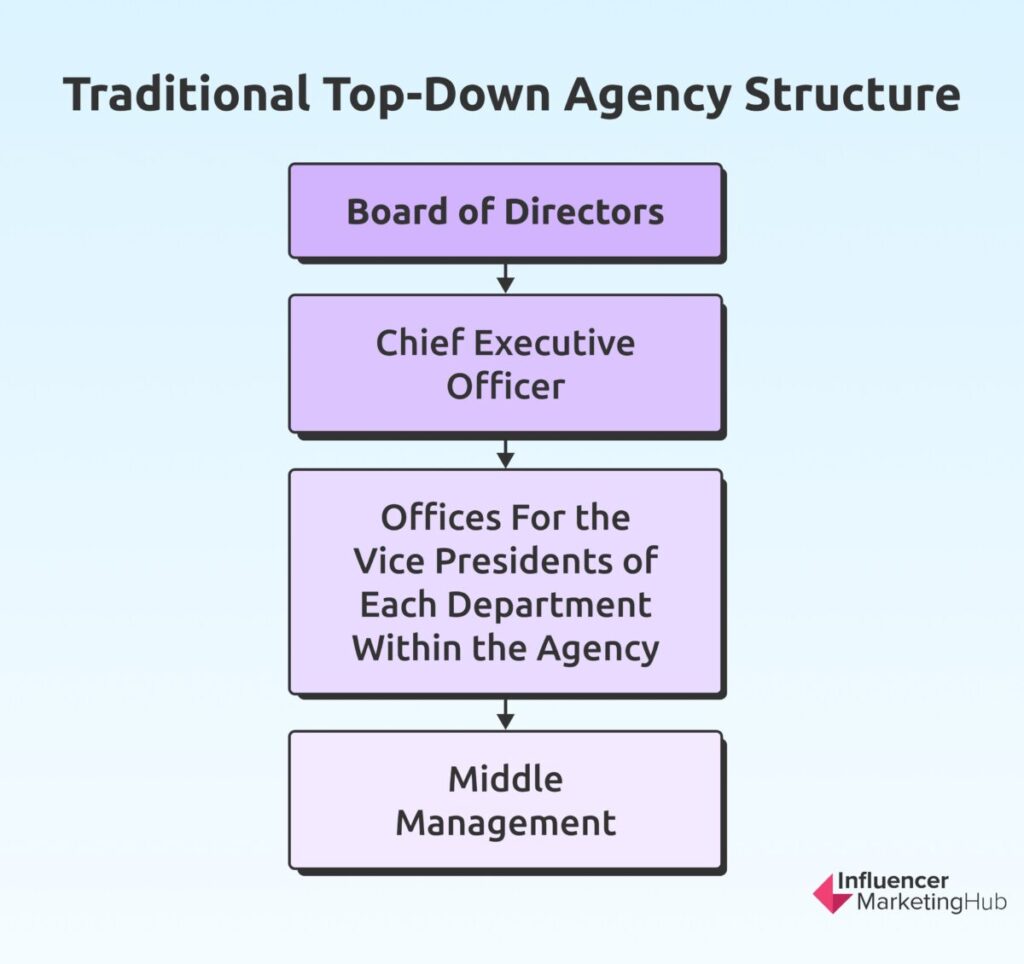
As with many other types of organization, marketing agencies have traditionally followed a top-down hierarchical model. You will find thousands (maybe even millions globally) of businesses of all types still follow this model. Companies using this approach tend to establish a clear chain of command, which you can easily depict in a structure diagram.
Visually, this is the typical business structure you most commonly see depicted in business media. In the case of an agency, it will often start with the Board of Directors, flowing down to the Chief Executive Officer. Beneath them, you might have branches for the VP of each of the agency’s divisions. In turn, specific department teams will flow from each VP, reflecting their area of responsibility. Larger agencies may have levels of middle management, lengthening the number of levels in the structure.
The links in this model reflect chains of responsibility. If you look at any person (role) in the chart, a line leading upwards indicates who that person is responsible to. In turn, any downward lines indicate who that person has responsibility for. Similarly, any particular role in the chart will report to the role directly above them and will have those below them reporting to them.
You do have to be of a reasonable size for this model to make sense, however, otherwise, you will simply lack sufficient staff to cover all the roles. This approach is irrelevant for small sole trader or freelancer agencies, where one person does everything, apart from what they contract out.
2. Functional
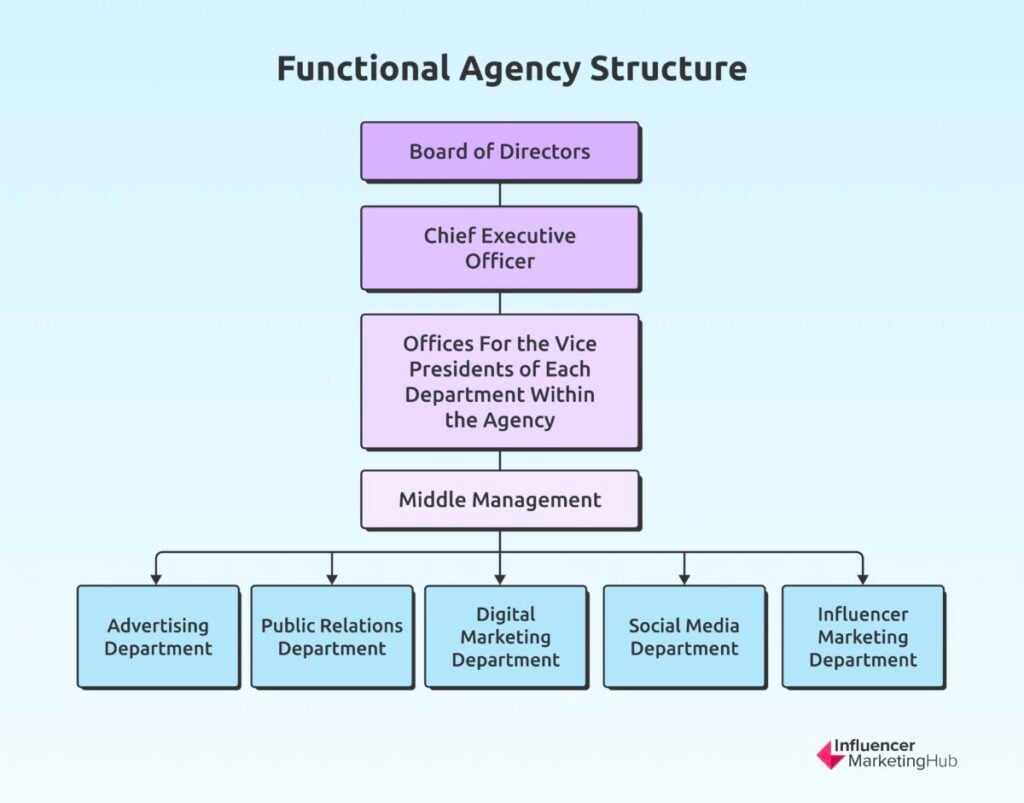
The Functional structure format is a subset of the Traditional Top-Down structure. This structure emphasizes departments related to function, for example, you may have separate Advertising, Public Relations, Digital Marketing, Social Media, and Influencer Marketing departments. The middle levels of your hierarchical structure will reflect the leadership within each functional department, with the rest of your workforce placed beneath the relevant leaders. Each worker is responsible to (and reports to) the leader of their designated department.
3. Geographic
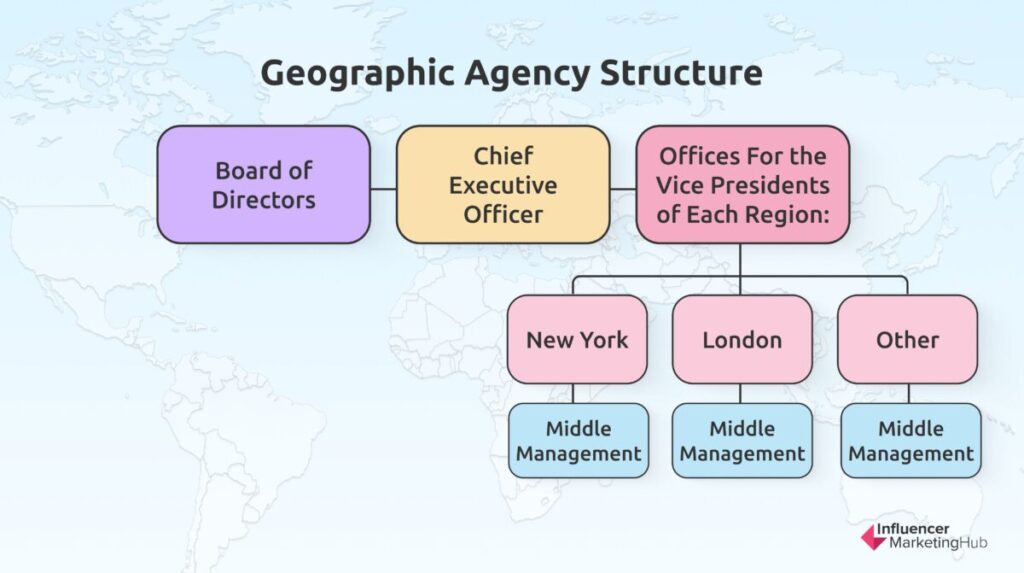
The Geographic structure is another variation of the Traditional Top-Down model, but it is used by agencies with operations in multiple locations. Here you separate your marketers by their location or region, rather than their function. For example, you may have a middle-management leader responsible for your New York office. Another leader may oversee your London office.
Some large agencies may mix the Functional and Geographic structures. For example, you may have a VP of Marketing – London, and beneath that a series of team leaders, including a Head of Social Media Marketing –London.
4. Flat
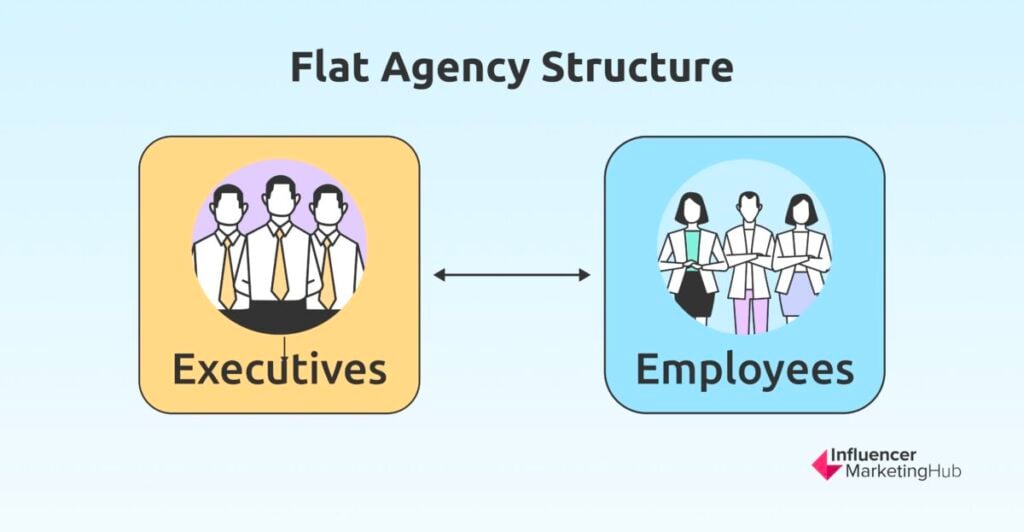
As its name suggests, the Flat agency structure removes hierarchies, doing away with middle management levels. This system highlights employee autonomy and emphasizes direct communication, rather than via “managers”.
This doesn’t mean that you do away with management completely, however. However, the reporting and responsibilities aren’t clear-cut like other structures, and team members can freely express their viewpoints.
5. Squads or Pods
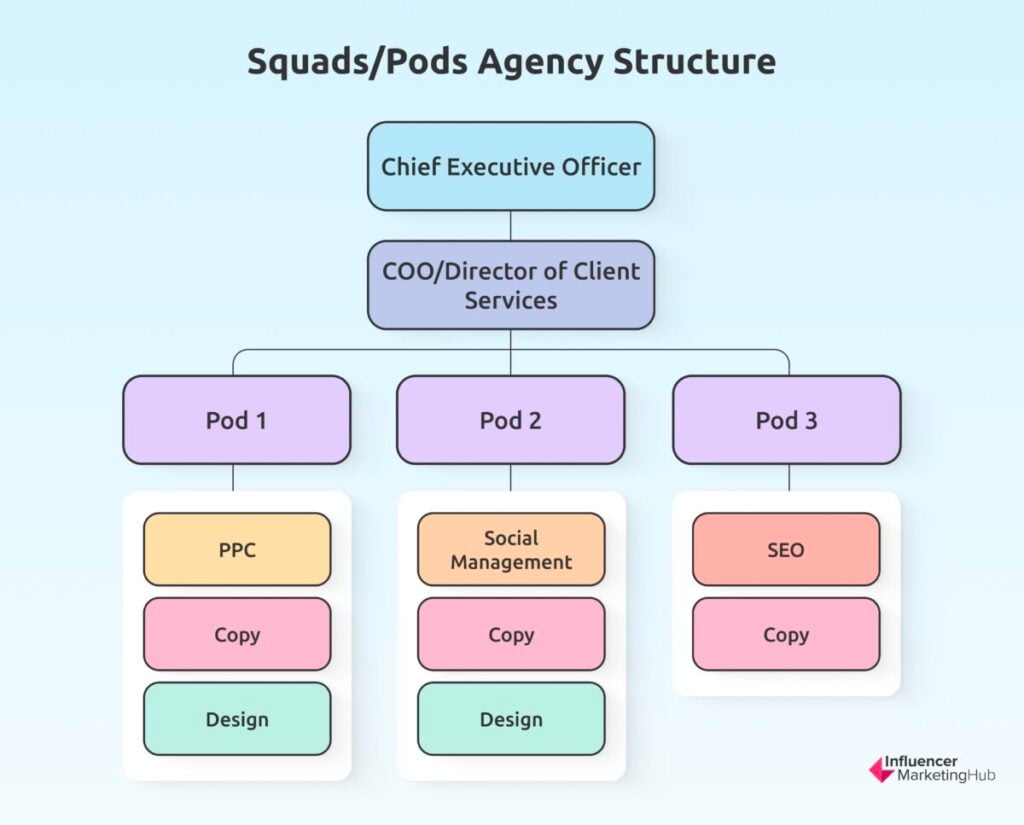
With the Pod (aka Squad) model, you create a series of cross-functional teams/pods/squads to work on specific projects. A common way that some agencies adapt this structure is to create pods/squads for particular accounts. Ensure that you have included team members covering all necessary skills in each pod/squad.
This structure is particularly suited to agencies that like to allow their staff to specialize by client, rather than having a more general approach to their work. For example, if you have graphic artists in your team, you will have each graphic artist working only on the clients allocated to their pod/squad, not taking on new work, or creating images for other clients.
This model is often used by agencies that follow the Agile methodology. This is a project management system, where a project (perhaps a campaign for a single client) is broken into various phases, with teams continually planning, executing, and evaluating their work. Although the Agile model was initially designed for software development, its use has expanded into many other sectors where the work can be organized by discrete teams. This approach has become popular as more agencies use remote workers.
The exact composition of each pod/squad will typically vary, depending on the needs of a particular client and the services your agency offers. For example, one pod may include team members representing PPC, Copy, and Design. A pod for another client may include team members representing social management, Copy, and Design, while a third may include SEO, and Copy only.
6. Matrix
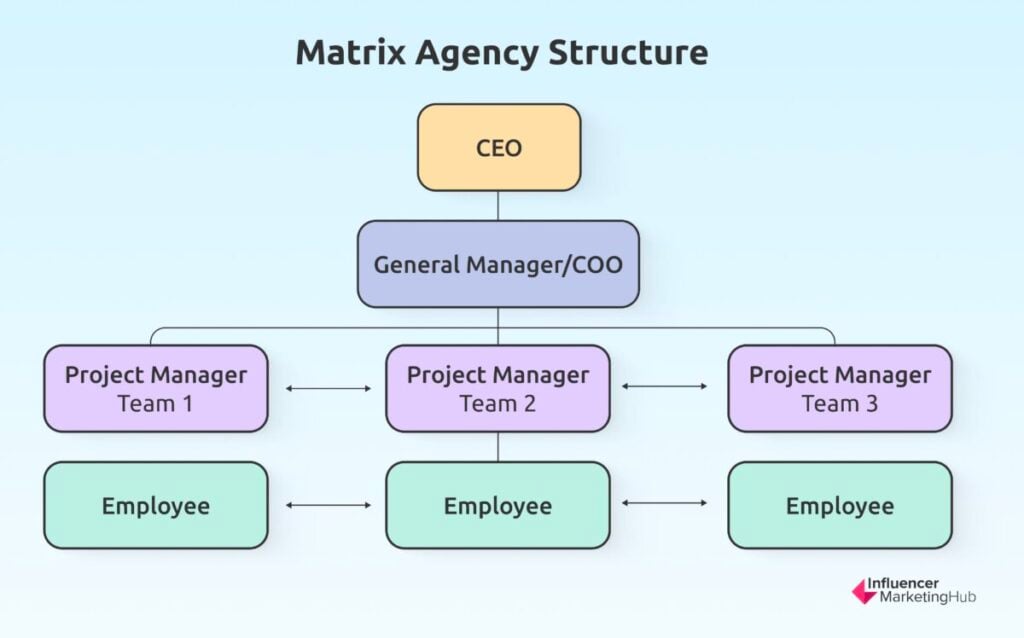
The Matrix structure is a hybrid of the Squad/Pod system and the Traditional Top-Down approach. Here you put your employees into teams, for example, teams dedicated to clients, but at the same time you allow them to work on other tasks, when necessary, i.e. you take a cross-functional approach.
Matrix structures can be complex. Employees in a matrix model may report to both a functional manager and a project manager. For example, all your copywriters may report (and be responsible to) a VIP of Creative. They will also, however, report to the team leader of each project they participate in.
The matrix structure gives much flexibility for the agency. It gives team members an overall base, depending on their skills, while at the same time allowing them to switch easily between project-based teams as needed.
7. Freelance
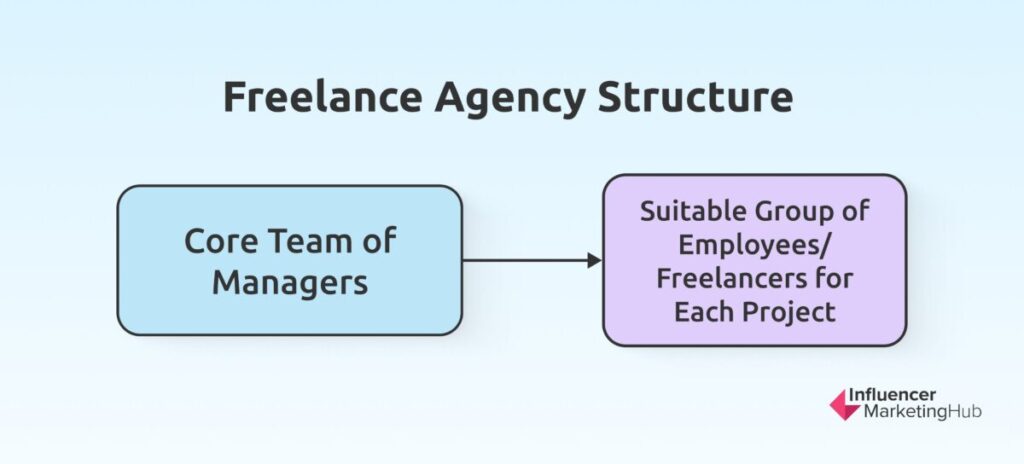
The above structures all work best when you have a large internal team of employees who you can place into the relevant positions. Of course, not all agencies work that way. Many are small and rely on freelancers and external contractors to provide the necessary skills for many projects.
A Freelance agency will usually have a core team that manages projects and often also client relationships. Whenever the agency gains a client or begins a new project, one of the core team members assembles the most suitable group of people for the project.
This is similar to how the Pod structure works, except the teams are likely to include necessary freelancers, e.g. writers, designers, videographers, and more.
Once a project is completed, the relevant team disbands, with the freelancers moving on to new jobs (either something new for this agency or for somebody else entirely).
How do these Structures Work for Agencies That Function Remotely?
As with other industries, many marketing agencies now operate partially or fully remotely. The arrival of COVID-19 in 2020, and the many restrictions governments and health agencies imposed, meant that agencies had to find new ways to function.
This coincided with improved technology and internet bandwidth, meaning that even everyday people became used to Zoom conversations and operating out of a home office. In addition, many agencies that previously operated from a set location, and promoted their work to their local market, began to take orders from around the world. They realized that much of an agency’s work can be performed remotely, and many of the deliverables are electronic.
The Freelance agency structure we described above is predicated on having a remote team, however, you can easily adapt many of the other structures to cater to a remote workforce (and indeed customer base) too.
Marketing agencies with a remote workforce have to adapt their strategies to recognize that some employees work from their offices (there may be multiple branches across the world), while others work from their homes, or use co-working spaces. And marketing agencies of all types may opt to work with some freelancers, particularly for specialist activities.
In this situation, you need to ensure that your marketing agency structure includes all the necessary communication tools and structures to ensure that the model functions as intended. For example, if you use the Pod structure, you need to have systems in place to ensure that all members of a team can communicate as easily as if they were sitting in a room together.
Wrapping Things Up
No two marketing agencies are alike. Therefore, it is impossible to recommend some form of “best” marketing agency structure. Instead, you have to choose the structure that works best with your agency. As we’ve said above, you should be prepared to examine and review your structure to ensure that it continues to meet your requirements as you grow.


